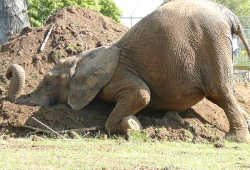Dorothy – 20/6/98
Can this virus endanger the health of human beings?
More on the Interview with Dr Al Smith. If you
haven’t already, you may want to
read Part 1.
Potential human health effects The possibility of human health effects worried the researchers in the very beginning because they knew that four out of the five calicivirus groups already were proven to be human pathogens, causing disease in people. That was their starting point.
What did they know about rabbit calicivirus to convince them that it would not infect people? Dr Smith’s reply was emphatic. “They know absolutely nothing.” People will often say that it is in forty two countries, and there is no evidence of illness. The question to be asked at that point is, ‘Have you looked? Is there an increase in hepatitis, in neurologic disease, in abortion, in gastro-enteritis, in influenza? Have you begun serologic surveys to see whether people have begun developing antibodies?’
This research has not been done. So when people say that there is no evidence of human infection it is simply a matter of them having not looked for the evidence or ignored the evidence that is there.
 |
| Dr Al Smith Photo source – Dr Neil Cherry |
What species are affected? We have a virus which almost for sure will move between species. We don’t know which species, but the evidence shows beyond doubt that it is not species specific. If it moves between species what species will it infect?
Monitoring of at-risk workers in Mexico There was an outbreak of rabbit haemorrhagic disease in Mexico which was eradicated. The Mexicans monitored the people working in the eradication programme. One of their workers sero-converted – that is he went from negative (no antibody to rabbit haemorrhagic disease) to developing antibody to rabbit haemorrhagic disease. That of course is the usual triggering mechanism for one to conclude that he had become infected though there is no proof that he was actually infected. Although unlikely, he could have got a huge amount of virus without becoming infected, but the fact is there that he developed antibody.
The Australians say that there was no evidence of infection, but the development of antibody is evidence, though not proof. They say that he must have come in contact with a lot of virus somewhere, and his body responded to the protein. His co-workers were not developing antibody. In Dr Smith’s view the obvious answer is that the man probably became infected. The Australians take the low probability that he was not infected. If the answers are balanced against the information they always go for the no-risk answer.
Letters to politicians Dr Smith and Dr Matson wrote open letters to politicians in Australia and New Zealand badgering them severely against legalising the use of the virus because of the risks to human health.
The Australian response The Australian Minister for Primary Industries said that they would delay until a human health study was completed. This was a retrospective study from July 1997 going back for thirteen months over human population who had never been exposed to the virus and those who were exposed. Their health histories would be done and tests would be conducted to see if they had antibodies to the rabbit haemorrhagic disease. They interviewed about 105 people who had not been exposed to the virus, and 169 who had been exposed to rabbits, but not necessarily to the virus. They put this data together and handled it in such a way that they could conclude that there was no health effect.
The Australian health data was sent to the New Zealand Ministry of Health but was not made available to the general public. Yvonne van Roy eventually was able to obtain the data.
Dr Cherry’s response to the Australian data Dr Cherry looked at the Australian data and in one of the variable tables that they have put together noted a remarkable health effect – a doubling of a whole series of health conditions amongst those who were exposed as against those who were not exposed. His view has been backed up by Dr Matson who is an epidemiologist. The information has been published in a well-respected journal, ‘The Journal of Emerging Infectious Diseases’, published by the Centre for Disease Control in Atlanta, Georgia.
The article includes a list of the conditions that caliciviruses can cause. Skin blistering has been reported in sea mammals, swine, monkeys, cattle and humans. That blistering was caused by a different calicivirus from the rabbit haemorrhagic disease. Symptoms include vomiting, diarrhoea, abortion, penumonia, hepatitis, heart inflammation and encephalitis. This shows that a whole array of caliciviruses can cause a whole array of problems.
Dr Cherry’s table shows that there is almost twice the amount of expected overall illness in the two groups, i.e. the exposed and the non-exposed groups, in the periods when the exposure was low and the periods after the exposure.
Blood tests Using freedom of information the researchers tried to get the data on blood tests out of Australia for over a year. It has finally been sent to them.
The tests used may not be very reliable. If a serum sample is run to test antibody more than once the results may vary. Dr Matson said that he could not take an individual serum sample and get reliable results, but that if he took the samples from some two hundred people as a package and asked what is the average antibody level for all people he would get a number which proved to be about 5%.
Then he separated out who was exposed and who was not. Those who were above 5% were significant as they were the ones who had been exposed to rabbits. Those below five were those who had not. The people from southern Australia where most of the exposure took place were above five, the people who had been exposed after October when the virus escaped fell into the high group, as opposed to those who were sampled before the escape of the virus and fell into the low group.
The differences are real. Why did they occur? What is being measured is exposure and non-exposure, but there could be other factors. So the data simply indicates that researchers need to look. Proof has not been established, but a story has been established that is diametrically opposed to the story put out from Australia.
Diametrically opposed conclusions There are two groups of people looking at the same data, drawing opposite conclusions. They can’t both be right. Either the data is inadequate as a basis for proper conclusions or someone is wrong.
The group doing the current research outside Australia have been very open with their calculations and their data. Judith Carman, the epidemiologist who put the original data together, has agreed that world-recognised epidemiologists whom all the researchers can accept should be provided with the full complement of information and asked to see if they can draw any conclusions. Dr Matson and Dr Carman will provide names of human epidemiologists who they feel are competent and well-recognised. Because this is perhaps a disease transmissible from animals to people Dr Smith wants veterinary epidemiologists to be involved as well because public health is a big part of veterinary epidemiology.
The serologic data was brought to the meeting by Dr Matson. It caused a very strong anti-reaction from the Australian researchers who wanted him to give a public retraction of his research. ‘Let the data speak’ was the response.
Is New Zealand powerless since the release of the rabbit calicivirus? The Government through its processes is empowering the farmers to use the virus. Those who opposed the virus, basing their opposition on the uncertainties and all the reasons for which the Ministry of Agriculture and Fisheries turned it down are effectively disempowered by the Government retrospectively making legal an illegal act. Surely such an action is unacceptable in an ordered society.
The information provided by Dr Smith and Dr Matson makes it clear that the spokespersons for MAF underestimated the risks of cross-species infection and human infection. They had even more reason than they realised for advising against the introduction of the rabbit calicivirus.
Individual risk is small but significant The probability that each of us will become ill from the virus is very low, but if one person becomes ill through being infected that person provides an increased probability for others to become infected. The virus they shed can be human adapted.
Rabbit haemorrhagic calicivirus now not declared to be species specific The argument about the virus has shifted over time. At first it was said that it was species specific and would not mutate and that caliciviruses were not very mutagenic anyway. Now this is not stated because scientific books have established that caliciviruses belong to a class of viruses that are so mutagenic that if the genetic code for any two of them came out exactly the same it would be a mathematical accident. Their replicative mechanisms are so soft that they cannot repair mistakes, which means every virus replica will have somewhere between one and ten mistakes in its genetic code.
Each calicivirus is different and the way it survives is that it adapts to a host species very quickly. This allows it to find new host species that it has not known before. It infects new tissue systems (livers or brains or lungs, for instance), crosses between tissue systems, and crosses between species. That is the mechanism by which it persists in nature.
Change in the Australian position Over time the Australians have slid away from their original position and started talking about risk. In the beginning they said it would not infect humans and even that it was safe to eat rabbits that had been exposed to the virus. They have not stated that again.
They still maintain that it is species specific and that there is only a low risk of it infecting humans. What is low risk? If it is only the risk of a slight cold, that may be low risk. If it causes hospitalisation or abortion or even kills somebody, that is not low risk. Unless the risk is defined it is political doublespeak.
The story has subtly changed. That is one of the best indicators that officialdom really does understand what is being dealt with.
What can be done? If there is an epidemic the risk to non-target species is proportional to the virus load to which they are subjected. Therefore when there are dense populations of rabbits and rabbits being killed everywhere with the virus, then there is a high burden of calicivirus in the environment with which non-target species come into contact. This is a very dangerous situation. The more viruses to which something is exposed the more likely it is to get one that will cause it problems because it will be a mutant that will grow in a new host.
What should be done is to prevent the sale of the virus, and quit spreading the disease immediately. Spreading the disease should be made illegal.
Responsible people in responsible positions need to say that we must quit spreading the disease and use alternative methods for controlling rabbits. Then they must begin to set up some monitoring systems to see what may be the effect on non-target species. This needs to be done with people as well as animals.
Testing begun in New Zealand New Zealand has asked that question and put into effect a system where they are sampling people who have been exposed to the virus and sending the blood to be analysed. That particular project, in Dr Smith’s view, needs to be tuned up a little tighter with samples being sent to at least three labs as blind samples coded with control samples included amongst them. Then the results from the three labs need to be compared to see if the test is reliable.
More research is needed for new tests and validation and use over a wide sample. There is a need to develop good diagnostic reagents so that epidemiologic studies can be done. All species at risk need to be tested including human beings.
No vaccine for non-target species With monitoring systems and research programmes the only vaccine available is ground up rabbit liver. It is used only on rabbits. There is no vaccine and no protection for non-target species, including humans.
How can the life cycle of this virus be monitored? It is not possible to isolate the virus in a laboratory. It may take years to find a way of doing this. Symptoms which people experience will not and cannot be traced to the virus if assays are not available and if health officials do not look.
Possible research areas Research projects might involve monitoring the incidence of hepatitis over the next few years to see if there are increases and if so whether the introduction of rabbit haemorrhagic disease is a factor in the increase. Other possible research areas could be neurologic disease, bleeding disorders and abortion. As these occur in relatively low incidence it should be possible to gain accurate data and detect shifts. Influenza, gastro-enteritis, diarrhoea are ongoing through the population all the time, so they would be more difficult to monitor for meaningful data.
New Zealanders need increased awareness of the situation. New Zealanders need to understand clearly that they have added something to their ecosystems which was not there before, which can be, and is, dangerous to certain species, at present, perhaps only the rabbit population. This virus will work in determining part of the ecologic balances. Dr Smith warns that in his view it will continue to linger so that non-target species will be exposed to it from this point forward, and that includes the human population.
For more information check out
Dr Smith’s Web site.




